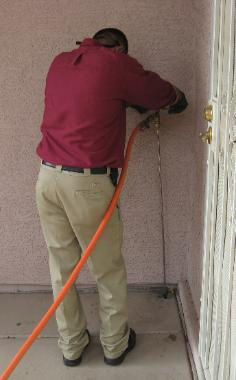TERMITES

Termite Tube

Termite Damage

Termite Mud Tube

Subterranean Termites

Stem Wall Treating

Horizontal Drilling

Down Drilling

Trenching and Rodding

Sub-Slab Injecting
Termites attack the wooden elements of human structures -- homes, businesses and warehouses. Their presence is not readily noticed because they hide their activity behind wall boards, siding or wood trim. Subterranean termites are social insects that live in nests or colonies in the soil, hence their name “subterranean.” These colonies contain three forms or castes: reproductive’s, workers and soldiers. Individuals of each caste have several stages: the egg; the larva that develops into a pseudergate and eventually into a brachypterous nymph or soldier; and the adult. Reproductive adults have three forms: primary, secondary and tertiary reproductive.
Reproductive males and females can be winged (primary) or wingless (secondary or tertiary). Each can produce new offspring. The bodies of primary reproductive’s, also called swarmers or alates, vary by species from coal black to pale yellow-brown. Wings may be pale or smoky gray to brown and have few distinct veins. Swarmer termites are about 1/4 to 3/8 inch long. Secondary and tertiary reproductive’s in the colony are generally white to cream-colored and may have short wing buds. Developed as needed, they replace a primary queen when she is injured or dies. They also develop in addition to the primary queen and lay eggs for the colony. Supplementary reproductive’s, including a group of males, workers and soldiers, may become isolated from the main colony and can establish a new colony. Termite workers make up the largest number of individuals within a colony. Workers are wingless, white to creamy white, and 1/4 to 3/8 inch long. They do all of the work of the colony -- feeding the other castes, grooming the queen, excavating the nest and making tunnels. In working, they chew and eat wood, causing the destruction that makes termites economically important.
Soldiers resemble workers in color and general appearance, except that soldiers have
large, well-developed brownish heads with strong mandibles or jaws. Soldiers defend
the colony against invaders, primarily ants. In some types of termites generally occurring
in arid regions, soldiers are called nasutes. Nasute soldiers have pear-shaped heads
with a long, tube-like projection on the front. They exude a sticky substance to entrap
their enemies. It is important to be able to distinguish between swarming termites and ants They often swarm around the same time of year, but control measures for each differ greatly. After a termite colony matures, which requires from 2 to 4 years, swarmers are produced. Swarming usually occurs from January through April, during the daylight hours, usually after a rain. Environmental factors such as heat, light and moisture trigger the emergence of swarmers. Each species has a definite set of conditions under which it swarms. The number of swarmers produced is proportionate to the age and size of the colony.
Both male and female swarmers fly from the colony and travel varying distances. They are extremely weak fliers; wind currents usually carry those that travel any distance. Only a small percentage of swarmers survive to develop colonies; the majority fall prey to birds,toads, insects and other predators. Many also die from dehydration or injury.
Termite treatment requires specialized equipment such as drills, pressure injectors, pressure generating pumps and high-gallon tanks. Therefore, in almost every instance, using the services of professional pest control operators is recommended. They are familiar with construction principles and practices, have the necessary equipment, and know termite biology and habits. Members of the pest control industry who offer termite control may be licensed or certified by a state agency for competence in treatment procedures that provide safe and effective control